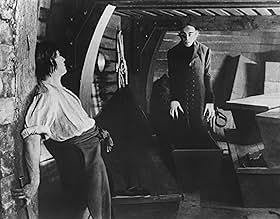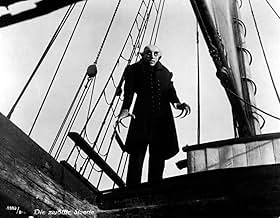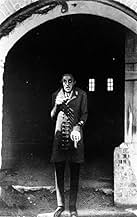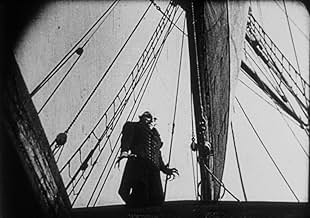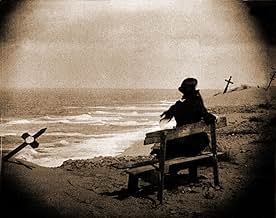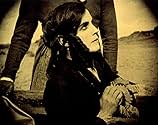El vampiro conde Orlok manifiesta su interés por una nueva residencia y por la esposa del agente inmobiliario Hutter.El vampiro conde Orlok manifiesta su interés por una nueva residencia y por la esposa del agente inmobiliario Hutter.El vampiro conde Orlok manifiesta su interés por una nueva residencia y por la esposa del agente inmobiliario Hutter.
- Premios
- 3 premios ganados y 2 nominaciones en total
Gustav von Wangenheim
- Hutter
- (as Gustav v. Wangenheim)
Greta Schröder
- Ellen - seine Frau
- (as Greta Schroeder)
Georg H. Schnell
- Harding - ein Reeder
- (as G.H. Schnell)
Karl Etlinger
- Kontrolleur am Kai
- (sin créditos)
Hans Lanser-Ludolff
- A magistrate
- (sin créditos)
Loni Nest
- Child at Window
- (sin créditos)
Fritz Rasp
- Knocks Mitarbeiter
- (sin créditos)
Josef Sareny
- Head Coachman
- (sin créditos)
Fanny Schreck
- Krankenschwester im Hospital
- (sin créditos)
Eric van Viele
- Matrose 2
- (sin créditos)
- Dirección
- Guionistas
- Todo el elenco y el equipo
- Producción, taquilla y más en IMDbPro
Opinión destacada
Nosferatu is a great horror movie (possibly the first ever according to some accounts), and one of the pinnacles of the German silent era of film-making. Made in the silent age by the German expressionist/auteur FW Murnau, the film has the genuine power to act creepy, odd, alluring, mythic, and beautiful by way of images and music that don't leave your mind once the film is over. It's like someone collected a stash of nightmares and pulled them together with the original Bram Stoker story of Dracula. Max Shreck, in his most notorious role (and apparently the only one really anyone's bothered to see) plays the monstrous Count Orlock, a vampire who comes out at night to tempt the living and, of course, to suck blood. Though this story of Dracula has been numerously repeated (even by the Hollywood version in the early 30s), this film is one of the prime examples of how horror SHOULD be done- dispense with cheap thrills or overloading with exposition.
A director like Murnau here, who had total artistic control (abeit the film not in circulation for many years), could transform Orlock's world into one of acute, deliberate angles, long deep shadows, and painting with light like some mad artist from the dark ages. One could almost claim that this, alongside Night of the Living Dead, changed the way audiences looked at horror films, that a style and presence could be wrung from characters that bring out the worst fears and dread in common people. Years from now, long into the digital age, there may still be room for of all things a silent, non-talking effort like Nosferatu, where the terror can still be felt through the black and white (sometimes tinted) photography and stark physical performances by Schrek and the others. In short, a film like this is one of the reasons I love to watch horror movies.
A director like Murnau here, who had total artistic control (abeit the film not in circulation for many years), could transform Orlock's world into one of acute, deliberate angles, long deep shadows, and painting with light like some mad artist from the dark ages. One could almost claim that this, alongside Night of the Living Dead, changed the way audiences looked at horror films, that a style and presence could be wrung from characters that bring out the worst fears and dread in common people. Years from now, long into the digital age, there may still be room for of all things a silent, non-talking effort like Nosferatu, where the terror can still be felt through the black and white (sometimes tinted) photography and stark physical performances by Schrek and the others. In short, a film like this is one of the reasons I love to watch horror movies.
- Quinoa1984
- 24 abr 2000
- Enlace permanente
Argumento
¿Sabías que…?
- TriviaThe movie was banned in Sweden due to excessive horror. The ban was finally lifted in 1972.
- Errores(at around 30 mins) When Hutter is writing his letter to Ellen in Count Orlok's castle, the paper that he is meant to be writing on is clearly blank throughout the scene.
- Citas
Graf Orlok: Your wife has such a beautiful neck...
- Versiones alternativasThere are a confusing number of different surviving prints, restorations and alternate versions of Nosferatu. In the main, there are three 'complete' restorations and two incomplete, partially-restored versions. All five are available on DVD, while the latest two restorations, from 1995 and 2006, are also on Blu-ray. In addition there are countless low-quality public domain DVDs with different lengths, running speeds and soundtracks. All are derived from a single print held by the Museum of Modern Art (MoMA). They usually have replacement American intertitles and are always in black and white; the film was originally color tinted throughout and only meant to be seen that way. This comprehensive article explains all of them simply and clearly: Nosferatu: The Ultimate Blu-ray and DVD Guide.
- ConexionesEdited into Boo (1932)
- Bandas sonorasJeux d'enfants - Galop
Written by Jack Norworth
[Plays during the croquet scene in the 2006 restoration]
Selecciones populares
Inicia sesión para calificar y agrega a la lista de videos para obtener recomendaciones personalizadas
Detalles
- Fecha de lanzamiento
- País de origen
- Sitio oficial
- Idiomas
- También se conoce como
- Nosferatu: A Symphony of Horror
- Locaciones de filmación
- Starhrad Castle, Nezbudská Lúcka, Slovakia(castle in ruins)
- Productoras
- Ver más créditos de la compañía en IMDbPro
Taquilla
- Total a nivel mundial
- USD 45,595
- Tiempo de ejecución1 hora 34 minutos
- Mezcla de sonido
- Relación de aspecto
- 1.33 : 1
Contribuir a esta página
Sugiere una edición o agrega el contenido que falta

Principales brechas de datos
What is the Japanese language plot outline for Nosferatu (1922)?
Responda








